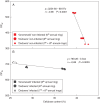Host responses and metabolic profiles of wood components in Dutch elm hybrids with a contrasting tolerance to Dutch elm disease
- PMID: 24854167
- PMCID: PMC4071097
- DOI: 10.1093/aob/mcu076
Host responses and metabolic profiles of wood components in Dutch elm hybrids with a contrasting tolerance to Dutch elm disease
Abstract
Background and aims: Changes occurring in the macromolecular traits of cell wall components in elm wood following attack by Ophiostoma novo-ulmi, the causative agent of Dutch elm disease (DED), are poorly understood. The purpose of this study was to compare host responses and the metabolic profiles of wood components for two Dutch elm (Ulmus) hybrids, 'Groeneveld' (a susceptible clone) and 'Dodoens' (a tolerant clone), that have contrasting survival strategies upon infection with the current prevalent strain of DED.
Methods: Ten-year-old plants of the hybrid elms were inoculated with O. novo-ulmi ssp. americana × novo-ulmi. Measurements were made of the content of main cell wall components and extractives, lignin monomer composition, macromolecular traits of cellulose and neutral saccharide composition.
Key results: Upon infection, medium molecular weight macromolecules of cellulose were degraded in both the susceptible and tolerant elm hybrids, resulting in the occurrence of secondary cell wall ruptures and cracks in the vessels, but rarely in the fibres. The (13)C nuclear magnetic resonance spectra revealed that loss of crystalline and non-crystalline cellulose regions occurred in parallel. The rate of cellulose degradation was influenced by the syringyl:guaiacyl ratio in lignin. Both hybrids commonly responded to the medium molecular weight cellulose degradation with the biosynthesis of high molecular weight macromolecules of cellulose, resulting in a significant increase in values for the degree of polymerization and polydispersity. Other responses of the hybrids included an increase in lignin content, a decrease in relative proportions of d-glucose, and an increase in proportions of d-xylose. Differential responses between the hybrids were found in the syringyl:guaiacyl ratio in lignin.
Conclusions: In susceptible 'Groeneveld' plants, syringyl-rich lignin provided a far greater degree of protection from cellulose degradation than in 'Dodoens', but only guaiacyl-rich lignin in 'Dodoens' plants was involved in successful defence against the fungus. This finding was confirmed by the associations of vanillin and vanillic acid with the DED-tolerant 'Dodoens' plants in a multivariate analysis of wood traits.
Keywords: Cellulose degradation; Dutch elm disease; Ophiostoma novo-ulmi; Ulmus; crystallinity; lignin; syringyl to guaiacyl ratio.
© The Author 2014. Published by Oxford University Press on behalf of the Annals of Botany Company. All rights reserved. For Permissions, please email: journals.permissions@oup.com.
Figures






References
-
- Adani F, Papa G, Schievano A, Cardinale G, D'Imporzano G, Tambone F. Nanoscale structure of the cell wall protecting cellulose from enzyme attack. Environmental Science & Technology. 2011;45:1107–1113. - PubMed
-
- Allwood JW, Ellis DI, Heald JK, Goodacre R, Mur LAJ. Metabolomic approaches reveal that phosphatidic and phosphatidyl glycerol phospholipids are major discriminatory non-polar metabolites in responses by Brachypodium distachyon to challenge by Magnaporthe grisea. Plant Journal. 2006;46:351–368. - PubMed
-
- Binz T, Canevascini G. Xylanases from the Dutch elm disease pathogens Ophiostoma ulmi and O. novo-ulmi. Physiological and Molecular Plant Pathology. 1996a;49:159–175.
-
- Binz T, Canevascini G. Differential production of extracellular laccase in the Dutch elm disease pathogens Ophiostoma ulmi and O. novo-ulmi. Mycological Research. 1996b;100:1060–1064.
-
- Brasier CM, Kirk SA. Designation of the EAN and NAN races of Ophiostoma novo-ulmi as subspecies. Mycological Research. 2001;105:547–554.
Publication types
MeSH terms
Substances
LinkOut - more resources
Full Text Sources
Other Literature Sources

